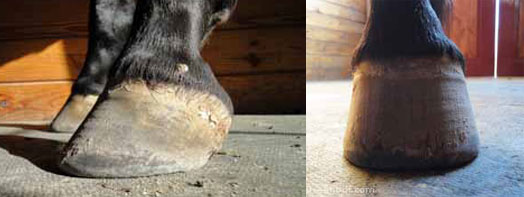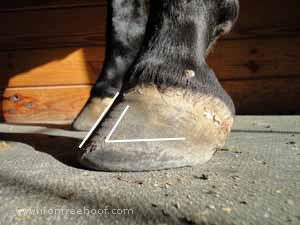|
Tall HoofHooves come in all shapes and sizes. This is a very tall hoof, but this PRE Andalusian mare works well with these feet. She was shown at third level dressage and was very competitive even in large open classes. She is now training fourth level and will be showing at this level this summer.
Andalusian Mare
I am going to talk about a couple of things that I see with these feet. Even though she is comfortable, I have some concerns. Impression
What jumps out at me is that this foot looks abnormally tall, yet when I turn it over, there is little hoof wall above the sole. The coronary band gives the impression of not being in the right place. I know this is a vague statement. Let me explain. I have put arrows pointing to the top edge of the lateral cartilage. Normally, the wall is not this high and there is more lateral cartilage above the coronary band. There is a term called distal descent. This is where the coffin bone has slipped further down into the hoof capsule. You could look at it another way, the hoof capsule has crawled higher up the leg. Distal Descent Analogy
The foot inside these socks is the same (just like the coffin bone and other structures). What is different is the sock (hoof wall).
BalanceThe medial/lateral (side-to-side) balance is pretty good. Once again, the coronary band looks pushed up all the way around the hoof, so all the wall looks too long. Coffin Bone on a Tall Hoof
I think the coffin bone is probably lined up with the hoof wall, but I think it is sitting lower in the hoof capsule than normal (possible distal descent). PriorityI have trimmed and owned quite a few Andalusians and Andalusian crosses. This is not an abnormal hoof for this breed. They often have extremely thick walls, lots of concavity and upright conformation. That being said, they often have insulin resistance and other metabolic problems too. Even though the hoof walls are not a lot taller than the sole, she still has good concavity. The concavity in the hoof and her comfort lead me to believe this is her normal hoof shape. If the concavity decreases or she gets foot sore, I will assume that she has developed metabolic issues. Right now, she is working hard and has a well balanced diet. Exercise and diet are very important for managing insulin resistance.
At this point in time, all I can do is shorten the hoof walls as much as possible and lower the heels a little. Lowering her heels too much causes the toe to shoot forward and puts lots of stress on the pastern. I rely on the periople at the back of the hoof to tell me when I can lower heels. I have found this to be a very good indicator. I have to cover this in another page, but thought I would mention it here. Concavity
You can see she has concavity. I know her frogs are not optimal. She is being treated for thrush. As bad as the frog looks, it was much smaller, more contracted and less functional when I first began trimming her. Like everything else, it has been a process getting them to improve. Tall Hoof - Frog on the Ground
I have lowered her heels and put the frog on the ground. I have been experimenting with how to trim her frogs. In the past, I neatened them up and trimmed the tags. Lately, I have been leaving the frog completely alone. It seems every little scrap of frog tissue helps fill the void and stimulate the back of the hoof. Her frogs are being treated for thrush. Tall Hoof - Sole
I thought you might like to see a picture of the sole. I have pulled the toe back almost to the white line. Let me state my priorities again. Return From Tall Hoof to the Natural Trimming page
|








